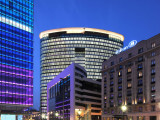Covent Garden Tower B
Saint-Josse-ten-Noode
- Facts
-
Metrics
You must be a CTBUH Member to view this resource.
Official Name
Covent Garden Tower B
Other Names
Royal Rogier
Type
Building
Status
Completed
Completion
2008
Country
City
Address
Function
A mixed-use tall building contains two or more functions (or uses), where each of the functions occupy a significant proportion of the tower's total space. Support areas such as car parks and mechanical plant space do not constitute mixed-use functions. Functions are denoted on CTBUH "Tallest Building" lists in descending order, e.g., "hotel/office" indicates hotel function above office function.
Office
Structural Material
Both the main vertical/lateral structural elements and the floor spanning systems are constructed from steel. Note that a building of steel construction with a floor system of concrete planks or concrete slab on top of steel beams is still considered an “all-steel” structure as the concrete elements are not acting as the primary structure.
All-Concrete
Both the main vertical/lateral structural elements and the floor spanning systems are constructed from concrete which has been cast in place and utilizes steel reinforcement bars and/or steel reinforced concrete which has been precast as individual components and assembled together on-site.
All-Timber
Both the main vertical/lateral structural elements and the floor spanning systems are constructed from timber. An all-timber structure may include the use of localized non-timber connections between timber elements. Note that a building of timber construction with a floor system of concrete planks or concrete slab on top of timber beams is still considered an “all-timber” structure as the concrete elements are not acting as the primary structure.
Mixed-Structure
Utilizes distinct systems (e.g. all-steel, all-concrete, all-timber), one on top of the other. For example, a Steel Over Concrete indicates an all-steel structural system located on top of an all-concrete structural system, with the opposite true of Concrete Over Steel.
Composite
A combination of materials (e.g. steel, concrete, timber) are used together in the main structural elements. Examples include buildings which utilize: steel columns with a floor system of reinforced concrete beams; a steel frame system with a concrete core; concrete-encased steel columns; concrete-filled steel tubes; etc. Where known, the CTBUH database breaks out the materials used within a composite building’s primary structural elements.
All-Concrete
Height
99.8 m / 327 ft
Floors Above Ground
27
Floors Below Ground
3
Tower GFA
74,000 m² / 796,529 ft²
Rankings
-
By function
You must be a CTBUH Member to view this resource.
-
By material
You must be a CTBUH Member to view this resource.
Structural Engineer
The Design Engineer is usually involved in the front end design, typically taking the leadership role in the Schematic Design and Design Development, and then a monitoring role through the CD and CA phases.
You must be a CTBUH Member to view this resource.
Architect
Usually involved in the front end design, with a "typical" condition being that of a leadership role through either Schematic Design or Design Development, and then a monitoring role through the CD and CA phases.
Art & Build
Structural Engineer
The Design Engineer is usually involved in the front end design, typically taking the leadership role in the Schematic Design and Design Development, and then a monitoring role through the CD and CA phases.
Material Supplier
Material Supplier refers to organizations which supplied significant systems/materials for a building project (e.g. elevator suppliers, facade suppliers, etc).
Material Supplier refers to organizations which supplied significant systems/materials for a building project (e.g. elevator suppliers, facade suppliers, etc).
Mitsubishi Elevator Europe
About Covent Garden Tower B
Covent Garden is comprised of a high-rise and low-rise building, meant to become an urban signal announcing the North area, the only purpose-built high-rise business district of Brussels. From an urban point of view, the project blends in as much with the historic low-rise buildings it faces on one side, as it copes with the tall buildings it faces on two other sides. At ground level a pedestrian link is created between an existing park and a major public square via a landscaped garden-atrium.
The project implements many sustainable features, including operable window-boxes that allow for natural ventilation yet do not allow rainwater into the building. A radiant air-conditioning system is used, in which less energy is used to achieve the same comfort level as a traditional air-conditioning system. The radiant air-conditioning system or “cold ceiling” requires negligible maintenance and a very low overall cost. Fresh air enters the offices through ventilation grills in the ceilings and is extracted near the lighting after being drawn across the offices.
Lastly, Covent Garden is equipped with an installation which in its specific application is a first in Belgium: the garden of the atrium is not only a major meeting space within the complex, it is also an “Eco-Machine” meant to organize wastewater recovery.
The Eco-Machine is a wastewater treatment process that treats both grey and black water, using advanced biological and bacteriological purification techniques. The system proceeds initially by sedimentation in a septic tank and biological purification with nitrification: the bacteria are held in free suspension in the water and the biomass is filtered through membranes. In a second stage, the water transits via the covered garden into vats with helophytes, which play a fine purification role.
The objective is to treat this water so that it can be recycled into the building’s own consumption cycle. Water is recovered at the end of the process and is stored in a pond. Although not drinkable, it is re-injected into the building for sanitary uses (washrooms), for building maintenance and for watering the plantings.
Subscribe below to receive periodic updates from CTBUH on the latest Tall Building and Urban news and CTBUH initiatives, including our monthly newsletter. Fields with a red asterisk (*) next to them are required.
View our privacy policy


